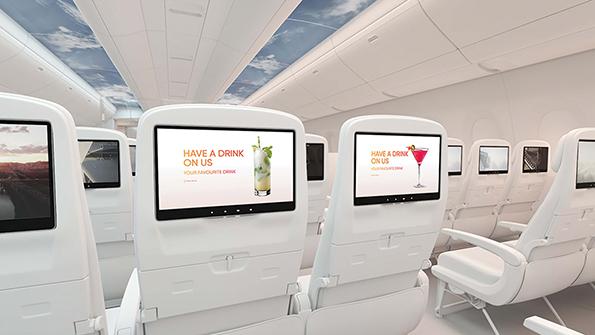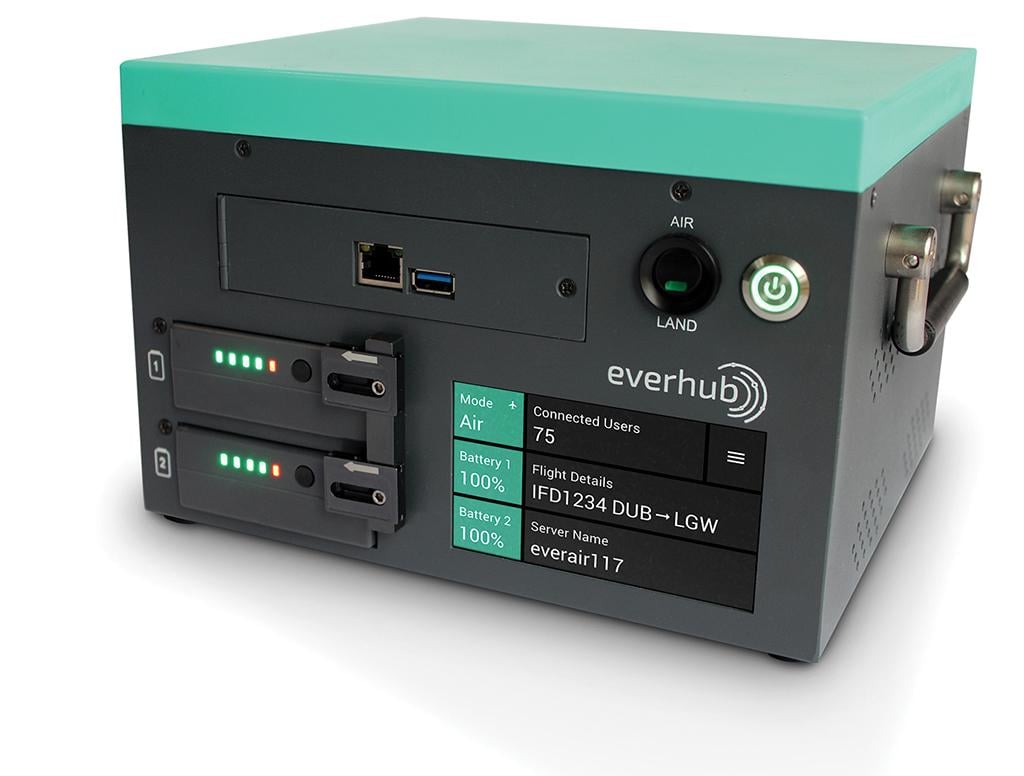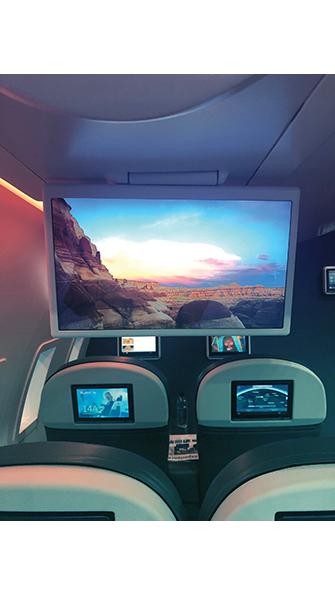
With the proliferation of smartphones and tablet devices, airline passengers are seeking a seamless connectivity experience in their homes and offices as well as in the aircraft cabin. The airlines know this, and providers of inflight entertainment are responding.
A notable trend is “concurrent consumption” of both entertainment and connectivity services, according to Josh Marks, CEO of Anuvu, a content services provider. Passengers typically use the same smartphones or tablets for work-related messaging and cloud collaboration as they do for TikTok, Reels or YouTube, he explains.
“In parallel, they are using seat-back screens to watch movies or episodic television, expecting the same diversity of content they find on subscription services like Netflix or Disney+,” Marks says. He notes that inflight entertainment (IFE) interfaces and content libraries need to reflect at-home experiences. “Video-rich social media, which makes greater demands on the network than streaming,” is now replacing movie streaming as the primary passenger-use case, mandating changing network requirements, he says.
“Upload speed from aircraft to ground is becoming critical, as social media apps depend on two-way cloud connectivity to power their ‘infinite scroll’ interfaces,” he explains. “To meet this requirement, Anuvu is launching our own vertically integrated geostationary satellites, engineered for interoperability with LEO networks.
“Today’s satellite network has to adapt to a social-media-driven future, and specifically designed for aviation,” Marks says. “Every aspect of our technology, including the network control software and digital payload on the satellite, has been redesigned to take advantage of that—and to work with existing aircraft antennas.”

In 2018, Anuvu digitalized its content-processing architecture and launched what he says is the industry’s only end-to-end—studio-to-airplane—cloud-based content supply chain that mirrors what modern streaming platforms have built while enabling the airline to decide how the content is displayed in the cabin. “Anuvu recognized that the media value chain needed to modernize to keep pace with the latest IFE systems,” he says, adding that prior to this, content would be manually loaded by a technician, with little automation.
Anuvu’s current focus is on the link from cloud to aircraft. “Pushing content updates to aircraft, touch-free, at the gate or over satellite links requires deep integration between seat-back OEMs and content services providers,” he says. “At Anuvu, we dynamically update content in real time on aircraft with our satellite connectivity systems, so targeting content to individual passengers and routes isn’t just possible, it’s reality.”
According to Tracy Trent, CEO of Fort Worth-headquartered Stellar Blu, the future of IFE will be tied to higher performance and greater capacity.
A specialist in high-performance terminals, Stellar Blu is introducing Sidewinder, which has been specifically designed to work with electronically steerable antennas. It is a collaborative project with antenna supplier Ball Aerospace and OneWeb, an operator of low-Earth-orbit satellites.
“The collaboration with Ball Aerospace has led to a product that is easily removed and reinstalled for maintenance support and customized to an airline’s needs,” says Trent, who likens Sidewinder’s design to Lego blocks.
“This makes the server easy to configure to interface with multiple satellite constellations and service providers—and to expand or scale down,” he explains. “It also is designed with a common adapter and avionics, so that there is minimal impact on the airframe, with upgrades or changes accomplished within minutes.”
The system includes a modem and server connected with wireless access points on the aircraft. Mounting could be done in the aircraft crown, under the floor, the electronics bay or crew area. Trent says it can be scaled for installation on aircraft sizes from a small business jet to a large twin-aisle airliner.
The first version of Sidewinder is slated to commence flight testing in June and continue throughout the remainder of 2022 on a Boeing 777-200LR, expanding to a regional jet later this year. In 2023, Sidewinder’s second version is scheduled to undergo flight tests on a Bombardier Global 6500. The testing will include the total certification package, encompassing the antenna, adapter plate, the terminal itself, avionics, modem, server, wireless access and all software needed to integrate and manage these pieces to airline standards. Sidewinder’s first and second versions are planned for delivery in the first and second quarters of 2023, respectively.
Personal Devices
Personal electronic devices (PED), used in conjunction with seat-back systems, are becoming more common, along with the ability to charge the newer-generation PEDs at up to 60 watts over USB ports, according to David Pook, a vice president for Burrana, an IFE developer based in Australia. “Enabling passengers to use their own Bluetooth headphones is now a common requirement,” he says. “The expectation is for these to become standard on aircraft so that the IFE system supports the PEDs, which will be the center of the IFE experience, rather than the other way around.”
DigEcor, rebranded as Burrana following the acquisition of Collins Aerospace’s IFE business in 2019, offers RISE Power, a USB charging option. “RISE Overhead and RISE Wireless are on the near-term horizon as well as a cost-effective technology upgrade path for our large PAVES Broadcast install base,” he notes.

Interestingly, Pook says the latest technology from the consumer electronics and automotive industries is making IFE cabin components smaller and lighter while consuming less power. At the same time, new technology is offering longer life spans prior to becoming obsolete.
Advancements to the RISE platform now in development “utilize much of this new technology in order to provide solutions that solve many of the challenges presented by traditional closed, heavy, expensive and unreliable IFE solutions,” Pook remarks.
Barry Flynn, chief commercial officer of Inflight Dublin, notes that passengers and crew are looking for more digital communication options for onboard services.
“Using passengers’ own devices to make requests, place orders and communicate with the crew is an important development that we have seen the demand for grow, particularly due to the pandemic, where a digital, touch-free service has become the preferred option,” Flynn says.
Inflight Dublin has developed a crew app for managing and fulfilling onboard retail, supporting duty-free and food and beverage purchases, producing operational efficiencies for ordering and delivering, and improved communications between passengers and crew, he says. “Multiple payment options can also be integrated with Inflight Dublin’s Everhub solution to ensure an optimized service for crew and passengers,” he adds.
Another notable IFE development is happening with content updates. Legacy IFE systems were built on proprietary software platforms, making it expensive and slow—taking as much as 60-90 days—for airlines to update their IFE content or even make software or user interface changes, says Mark Smith, director of sales at AERQ in Hamburg, Germany. “By incorporating the same cloud technology D2C [direct-to-consumer] streaming companies use today, AERQ has reduced current content lead times tremendously and is working on reducing that even further,” he says.
Smith notes this is being accomplished through AERQ’s Aerena platform, based on an open software architecture, allowing virtual testing and addressing any bugs. “This allows rapid development and deployment of new digital services and applications offered by AERQ, third parties and/or the airline’s own partners,” he notes.
AERQ uses a seat-centric design, so that the content file is pushed to the seat’s display and saved there. “The seat display includes content storage space which is larger than the total file server storage on some legacy IFE systems today,” he points out. “If an AERQ file server or network fails, the passenger can continue to enjoy a large selection of content from his or her seat.”






